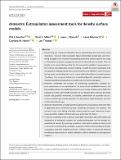Files in this item
dsmextra : extrapolation assessment tools for density surface models
Item metadata
| dc.contributor.author | Bouchet, Phil | |
| dc.contributor.author | Miller, David L. | |
| dc.contributor.author | Roberts, Jason | |
| dc.contributor.author | Mannocci, Laura | |
| dc.contributor.author | Harris, Catriona M | |
| dc.contributor.author | Thomas, Len | |
| dc.date.accessioned | 2020-09-23T10:30:03Z | |
| dc.date.available | 2020-09-23T10:30:03Z | |
| dc.date.issued | 2020-11 | |
| dc.identifier | 269726540 | |
| dc.identifier | 24ded057-2355-4fe8-89c4-c08c0a336f8e | |
| dc.identifier | 85091288981 | |
| dc.identifier | 000571593200001 | |
| dc.identifier.citation | Bouchet , P , Miller , D L , Roberts , J , Mannocci , L , Harris , C M & Thomas , L 2020 , ' dsmextra : extrapolation assessment tools for density surface models ' , Methods in Ecology and Evolution , vol. 11 , no. 11 , pp. 1464-1469 . https://doi.org/10.1111/2041-210X.13469 | en |
| dc.identifier.issn | 2041-210X | |
| dc.identifier.other | ORCID: /0000-0002-7436-067X/work/80995190 | |
| dc.identifier.other | ORCID: /0000-0001-9198-2414/work/80995248 | |
| dc.identifier.other | ORCID: /0000-0002-2144-2049/work/80995405 | |
| dc.identifier.uri | https://hdl.handle.net/10023/20673 | |
| dc.description | This work was funded by OPNAV N45 and the SURTASS LFA Settlement Agreement, managed by the U.S. Navy’s Living Marine Resources program under Contract No. N39430-17-C-1982. | en |
| dc.description.abstract | 1. Forecasting the responses of biodiversity to global change has never been more important. However, many ecologists faced with limited sample sizes and shoestring budgets often resort to extrapolating predictive models beyond the range of their data to support management actions in data‐deficient contexts. This can lead to error‐prone inference that has the potential to misdirect conservation interventions and undermine decision‐making. Despite the perils associated with extrapolation, little guidance exists on the best way to identify it when it occurs, leaving users questioning how much credence they should place in model outputs. To address this, we present dsmextra, a new R package for measuring, summarizing and visualizing extrapolation in multivariate environmental space. 2. dsmextra automates the process of conducting quantitative, spatially explicit assessments of extrapolation on the basis of two established metrics: the Extrapolation Detection (ExDet) tool and the percentage of data nearby (%N). The package provides user‐friendly functions to (a) calculate these metrics, (b) create tabular and graphical summaries, (c) explore combinations of covariate sets as a means of informing covariate selection and (d) produce visual displays in the form of interactive html maps. 3. dsmextra implements a model‐agnostic approach to extrapolation detection that is applicable across taxonomic groups, modelling techniques and datasets. We present a case study fitting a density surface model to visual detections of pantropical spotted dolphins Stenella attenuata in the Gulf of Mexico. 4. Predictive modelling seeks to deliver actionable information about the states and trajectories of ecological systems, yet model performance can be strongly impaired out of sample. By assessing conditions under which models are likely to fail or succeed in extrapolating, ecologists may gain a better understanding of biological patterns and their underlying drivers. Critical to this is a concerted effort to standardize best practice in model evaluation, with an emphasis on extrapolative capacity. | |
| dc.format.extent | 6 | |
| dc.format.extent | 1043753 | |
| dc.language.iso | eng | |
| dc.relation.ispartof | Methods in Ecology and Evolution | en |
| dc.subject | Cetaceans | en |
| dc.subject | Distance sampling | en |
| dc.subject | Ecological predictions | en |
| dc.subject | Extrapolation | en |
| dc.subject | Model transferability | en |
| dc.subject | R package | en |
| dc.subject | Spatial modelling | en |
| dc.subject | Wildlife surveys | en |
| dc.subject | QA Mathematics | en |
| dc.subject | QH301 Biology | en |
| dc.subject | DAS | en |
| dc.subject.lcc | QA | en |
| dc.subject.lcc | QH301 | en |
| dc.title | dsmextra : extrapolation assessment tools for density surface models | en |
| dc.type | Journal article | en |
| dc.contributor.institution | University of St Andrews. School of Mathematics and Statistics | en |
| dc.contributor.institution | University of St Andrews. Office of the Principal | en |
| dc.contributor.institution | University of St Andrews. Scottish Oceans Institute | en |
| dc.contributor.institution | University of St Andrews. Centre for Research into Ecological & Environmental Modelling | en |
| dc.contributor.institution | University of St Andrews. School of Biology | en |
| dc.contributor.institution | University of St Andrews. Sea Mammal Research Unit | en |
| dc.contributor.institution | University of St Andrews. Applied Mathematics | en |
| dc.contributor.institution | University of St Andrews. Statistics | en |
| dc.contributor.institution | University of St Andrews. Marine Alliance for Science & Technology Scotland | en |
| dc.identifier.doi | 10.1111/2041-210X.13469 | |
| dc.description.status | Peer reviewed | en |
This item appears in the following Collection(s)
Items in the St Andrews Research Repository are protected by copyright, with all rights reserved, unless otherwise indicated.

